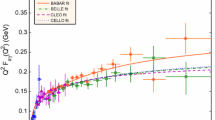Summary
The possibility of applying optimal extrapolation techniques to the determination of the pion form factor from charged-pion electroproduction is discussed. With the data available at present, the uncertainty in the pion form factor is very large. It is suggested that the use of some additional information in the unphysical region might be useful. As an example, a well-known kinematical constraint is used in conjunction with threshold electroproduction data to determine the pion form factor at a timelike momentum transfer of approximately one fm−2. Some implications of this model-independent determination of the form factor for the pion charge radius are discussed.
Riassunto
Si discute la possibilità di applicare tecniche di estrapolazione ottimali per derivare il fattore di forma del pione da elettroproduzione di pioni carichi. Con i dati attualmente a disposizione, l’indeterminazione sul fattore di forma del pione è grossa. Si suggerisce che l’uso di qualche informazione ulteriore nella regione non fisica possa essere di qualche utilità. A titolo di esempio, si utilizza un ben noto vincolo cinematico in congiunzione con dei dati di elettroproduzione a soglia per determinare il fattore di forma del pione ad un valore del momento trasferito di tipo tempo e di approssimativamente 1 fm−2. Si discutono infine alcune possibili utilizzazioni del fattore di forma del pione.
Реэюме
Обсуждается воэможность применения техники оптимальной зкстра-поляции для определения форм-фактора пиона иэ злектророждения эаряженных пионов. Исходя иэ данных, имеюшихся на сегоднящний день, неопределенность в форм-факторе пиона окаэывается очень больщой. Предлагается, что испольэование некоторой дополнительной информации в нефиэической области может быть поле-эным. Как пример, испольэуется хорощо иэвестное кинематическое ограничение вместе с данными по пороговому злектророждению для определения форм-фактора пиона при времениподобном передаваемом импульсе, приблиэительно равном 1 fm−2. Обсуждаются некоторые следствия зтого не эависяшего от модели опре-деления форм-фактора для радиуса эаряда пиона.
Similar content being viewed by others
References
V. Auslander, G. I. Budker, Ju. N. Peskov, V. A. Sidorov, A. V. Skrinsky andA. G. Khabakhpashev:Phys. Lett.,25 B, 433 (1967).
J. Augustin, J. C. Bizot, J. Haissinski, D. Lalanne, P. C. Harin, J. Perez y Jorba, F. Rumpf, E. Silva andS. Tavernier:Phys. Rev. Lett.,20, 129 (1968);Phys. Lett.,28 B, 508 (1969).
G. Salvini:Bull. Ann. Phys. Soc.,16, 632 (1971).
See for instanceC. F. Cho andJ. J. Sakurai:Lett. Nuovo Cimento,2, 7 (1971).
R. E. Cutkosky andB. B. Deo:Phys. Rev.,174, 1859 (1968).
S. Ciulli:Nuovo Cimento,61 A, 787 (1969);62 A, 301 (1969).
For a complete review on the subject, see for instance:S. Ciulli:Stability problems in analytic continuation, inLecture Notes in Physics,17.
I. Raszillier:Commun. Math. Phys.,26, 1211 (1972).
I. Raszillier andW. Schmidt:Nucl. Phys.,55 B, 106 (1973).
G. Nenciu, I. Raszillier, W. Schmidt andH. Schneider: preprint (1973).
B. H. Kellett andC. Verzegnassi:Nuovo Cimento,13 A, 185 (1973).
P. S. Kummer, A. B. Clegg, F. Foster, G. Hughes, R. Siddle, J. Allison, B. Dickinson, E. Evangelides, M. Ibbotson, R. Lawson, R. S. Meabum, H. E. Montgomery, W. J. Shuttleworth andA. Safair:Lett. Nuovo Cimento,1, 1026 (1971).
C. N. Brown, C. R. Canizares, W. E. Cooper, A. M. Eisner, G. J. Feldman, C. A. Lichtenstein, L. Litt, W. Locheretz, V. B. Montana andF. M. Pipkin:Phys. Rev. Lett.,26, 987 (1971).
C. Dovier, K. Heinloth, K. Höhne, G. Hofmann, P. Karow, D. Schmidt, G. Specht andJ. Rathje:Phys. Lett.,35 B, 770 (1971).
F. A. Berends:Phys. Rev. D,1, 2590 (1970).
R. C. E. Devenish andD. H. Lyth:Phys. Rev. D,5, 47 (1972).
RecentlyDevenish andLyth (17) have attempted an evaluation of this subtraction constant by means of a fixed-s dispersion relation. However, this merely transfers the uncertainty to some assumption about the coupling of meson systems, such as (A1π) and (A2π), to the virtual photon, and their result is not conclusive.
R. Devenish andD. Lyth:The subtraction constant in electroproduction, V.C. London preprint (1973).
R. E. Cutkosky andB. B. Deo:Phys. Rev. Lett.,22, 1272 (1968).
B. B. Deo andM. K. Parida:Phys. Rev. Lett.,26, 1609 (1971).
S. L. Adler:Ann. of Phys.,50, 189 (1968).
We use the same conventions asJ. Gayler: DNPL/R 15.
E. Amaldi, B. Borgia, P. Pistilli, M. Balla, G. V. Di Giorgio, A. Giazotto, S. Serbassi andG. Stoppini:Nuovo Cimento,65 A, 377 (1970);E. Amaldi, M. Beneventano, B. Borgia, F. de Notaristefani, A. Frondaroli, P. Pistilli, I. Sestili andM. Severi:Phys. Lett.,41 B, 216 (1972).
D. R. Botterill, D. W. Braben, R. Kikuchi, P. R. Norton, A. Del Guerra, A. Giazotto, M. A. Giorgi andA. Stefanini:The total cross-section for π + electroproduction on hydrogen near threshold, preprint (1973).
E. D. Bloom, R. L. A. Cottrell, H. De Staebler, C. L. Jordan, H. G. Piel, C. Y. Prescott, R. Siemann, S. Stein andR. T. Taylor: SLAC-PUB-1195 (1973),
P. Brauel, F. W. Büsser, Th. Lanzler, D. Cords, W. R. Dix, R. Felst, G. Griendhammer, W. D. Kollmann, H. Krehbiel andJ. Meyer: DESY preprint (1973).
J. S. Ball:Phys. Rev.,124, 2014 (1961).
J. P. Burq:Ann. de Phys.,10, 363 (1965);B. B. Govorkov, S. P. Denisov andE. V. Minarik:Sov. Journ. Nucl. Phys.,4, 371 (1966).
A. Del Guerra, A. Giazotto, M. A. Giorgi, A. Stefanini, B. Kellett andC. Verzegnassi:The pion form factor at a timelike momentum transfer of approximately one fm−2 from π+ electroproduction at threshold, preprint (1973).
D. N. Levin, V. S. Mathur andS. Okubo:Phys. Rev. D,5, 912 (1972).
In a recent paper, however,Glück andPetzold:Nuovo Cimento,15 A, 244 (1973) suggest a lower bound onr π which is larger than our value.
M. Glück andJ. Petzold:Nuovo Cimento,15 A, 244 (1973).
For a complete review on the subject, seeM. Gourdin:Weak and electromagnetic form factors of hadrons, invited talk at theInternational Symposium on Electron and Photon Interactions at High Energies (Bonn, 1973).
Author information
Authors and Affiliations
Additional information
Work partially supported by INFN, Sezione di Trieste.
Rights and permissions
About this article
Cite this article
Kellett, B.H., Verzegnassi, C. Extrapolation techniques and the pion form factor. Nuov Cim A 20, 194–206 (1974). https://doi.org/10.1007/BF02727447
Received:
Published:
Issue Date:
DOI: https://doi.org/10.1007/BF02727447




